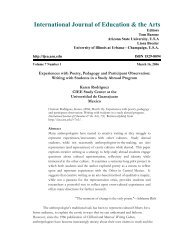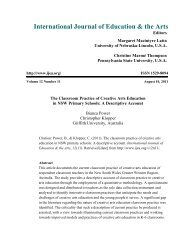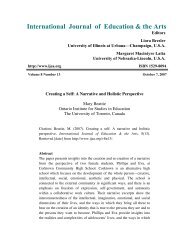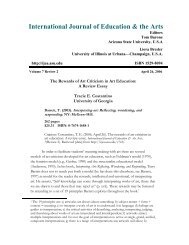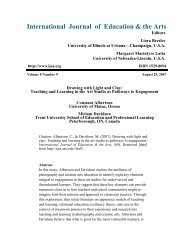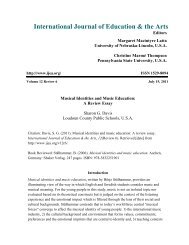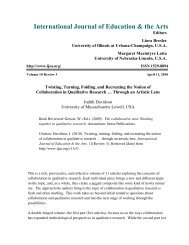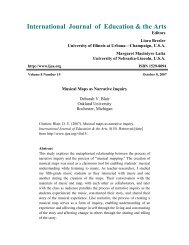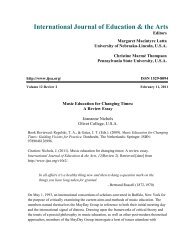On Empathy: The Mirror Neuron System and Art Education
On Empathy: The Mirror Neuron System and Art Education
On Empathy: The Mirror Neuron System and Art Education
Create successful ePaper yourself
Turn your PDF publications into a flip-book with our unique Google optimized e-Paper software.
IJEA Vol. 10 No. 15 - http://www.ijea.org/v10n15/ 12<br />
“participatory <strong>and</strong> dialogical practices” that include in the process an interdependence of self<br />
<strong>and</strong> others (Gablik, 1995, pp. 16-17).<br />
Empathic social interaction underpins Gablik’s (1995) advocacy of a “connective aesthetics,”<br />
which is “based vigorously in impassioned engagement that would restore art’s connectedness<br />
with the world after a century of vision-oriented, purist ideals” (p. 17). This “connective<br />
aesthetics,” as informed by dialogical practices, succeeds in reuniting aesthetics <strong>and</strong> empathy<br />
[Einfuhlung], but in ways unlike Lipps’ proposal of inner imitation or Vischer’s experience of<br />
transposition. Whereas the philosophers focused on the individual, Gablik envisions the<br />
communal <strong>and</strong> a kind of existentialist “sense of us” described by Iacoboni. More importantly,<br />
Gablik’s notions of connectedness are supported by the findings of existential neuroscience,<br />
<strong>and</strong> thus, offer a compelling biocultural model for an art education of empathy.<br />
<strong>The</strong> following passages offer a brief sketch of how this model was applied in an attempted<br />
move toward an art education of empathy. Preservice teachers, mostly without background in<br />
art, experienced the connectedness of the empathic-aesthetic community described below:<br />
A Resonant Connectedness in the Classroom<br />
Students in multicultural art education <strong>and</strong> elementary art methods courses reflected on class<br />
presentations one to two weeks after having been given, focusing particularly on those they<br />
had found most memorable <strong>and</strong> vivifying. Presentations featured works of art exhibited in<br />
local museums that were unfamiliar to students, but with which they felt a personal<br />
connection, nonetheless. In other presentations, students shared a cultural icon deemed to have<br />
some personal significance. Presenters explored their connections <strong>and</strong> shared contextualizing<br />
information about the selected pieces, which included, for example: a Japanese Inro box, a<br />
Nez Perce umbilical amulet, the Buddha Shakyamuni, Tiepolo’s Triumph of Virtue <strong>and</strong><br />
Nobility over Ignorance (1740-50), Cezanne’s Still Life with Apples (1893-94), Reni’s Saint<br />
Cecilia (1606), the iconic logos of Starbuck’s, the Gap, <strong>and</strong> the Los Angeles Lakers. i In their<br />
reflections, students sometimes described presenters’ honesty, facial expressions, or emotions,<br />
for example, mentioning a face that “showed a fierce, determined look,” or “passion <strong>and</strong><br />
excitement,” <strong>and</strong> eyes filled with tears.<br />
Overwhelmingly, students wrote about the connections between classmates <strong>and</strong> their chosen<br />
pieces, both in general <strong>and</strong> specific terms. Though they did not always remember a presenter’s<br />
name or have much in common with that individual, students had clear memories of these<br />
connections, their authenticity, impact, <strong>and</strong> meaning. A small composite of these reflections is<br />
offered in the following narrative:




